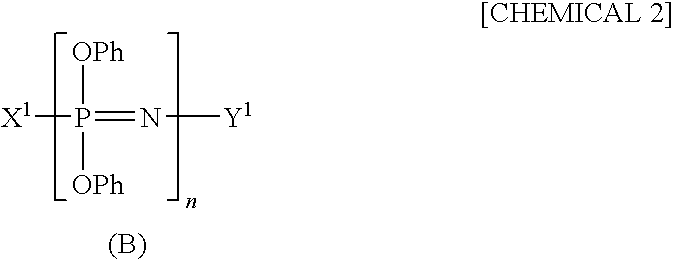Flame retardant and flame-retardant resin composition
a flame retardant and resin composition technology, applied in the field of flame retardant and flame retardant resin composition, can solve the problems of toxic antimony oxide compound, resin composition evolves toxic halogen, and cannot be used in isolation, so as to achieve good mechanical strength, suppress flame spread, and reduce the effect of shape destruction
- Summary
- Abstract
- Description
- Claims
- Application Information
AI Technical Summary
Benefits of technology
Problems solved by technology
Method used
Image
Examples
synthesis example 1
[0096]27.64 g of sodium carbonate, 4.91 g of lithium carbonate, 69.23 g of titanium dioxide and 74.56 g of potassium chloride were dry ground and mixed to provide a raw material which was subsequently fired at 1,100° C. for 4 hours. After the firing, a sample was immersed in 10 kg of purified water, stirred for 20 hours, separated, washed with water and then dried at 110° C. The resulting white powder was identified as layered titanate K0.8Li0.27Ti1.73O4 and had a mean major length of 44 μm and an interplanar spacing (unit thickness) a of 0.778 nm.
synthesis example 2
[0097]79.2 liter of a 10.9 aqueous slurry of the layered titanate obtained in Synthesis Example 1 was prepared, 4.7 kg of a 10% aqueous solution of sulfuric acid was added, a pH of the slurry was adjusted to 7.0. This slurry was separated, washed with water, dried at 110° C. and then fired at 600° C. for 12 hours. The resulting white powder was identified as layered titanate K0.6Li0.27Ti1.73O3.9 and had a mean major length of 44 μm and an interplanar spacing (unit thickness) a of 0.776 nm.
synthesis example 3
[0098]27.64 g of sodium carbonate, 4.91 g of lithium carbonate and 69.23 g of titanium dioxide were dry ground and mixed to provide a raw material which was subsequently fired at 950° C. for 4 hours. After the firing, a sample was immersed in 10 kg of purified water, stirred for 20 hours, separated, washed with water and then dried at 110° C. The resulting white powder was identified as layered titanate K0.8Li0.27Ti1.73O4 and had a mean major length of 9 μm and an interplanar spacing (unit thickness) a of 0.777 nm.
PUM
| Property | Measurement | Unit |
|---|---|---|
| length | aaaaa | aaaaa |
| length | aaaaa | aaaaa |
| aspect ratio | aaaaa | aaaaa |
Abstract
Description
Claims
Application Information
 Login to View More
Login to View More - R&D
- Intellectual Property
- Life Sciences
- Materials
- Tech Scout
- Unparalleled Data Quality
- Higher Quality Content
- 60% Fewer Hallucinations
Browse by: Latest US Patents, China's latest patents, Technical Efficacy Thesaurus, Application Domain, Technology Topic, Popular Technical Reports.
© 2025 PatSnap. All rights reserved.Legal|Privacy policy|Modern Slavery Act Transparency Statement|Sitemap|About US| Contact US: help@patsnap.com



